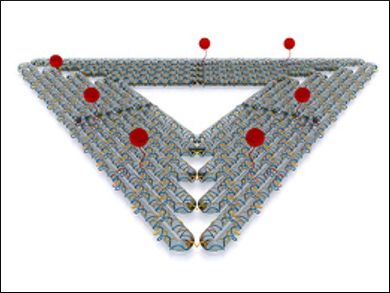Low-energy electrons are produced in large amounts when high-energy radiation traverses biological tissue, e.g., during medical radiation treatment used to reduce tumor tissue. The irradiation produces a shower of secondary low‐energy electrons, which are able to damage DNA very efficiently by dissociative electron attachment. It has been suggested that low‐energy electron‐induced DNA strand breaks strongly depend on the specific DNA sequence with a high sensitivity of guanine (G)‐rich sequences.
Ilko Bald and Jenny Rackwitz, University of Potsdam, Germany, have analyzed electron-induced strand breaks in DNA sequences derived from telomeric DNA. Telomeric DNA consists of guanine-rich repeating units located at the ends of chromosomes and plays an important role for the lifespan of a cell. The determination of low-energy-electron-induced strand breaks in specific oligonucleotide sequences was made possible by a novel technique based on DNA origami nanostructures.
The DNA target sequences were attached to triangular DNA origami platforms (pictured). After irradiation with electrons, the DNA nanostructures were imaged by atomic force microscopy (AFM). The AFM images revealed whether or not the target sequences were broken due to the electron irradiation. In this way, strand breaks in a whole range of telomere-derived sequences could be quantified and systematically compared.
The researchers found that the telomeric DNA (having a repeat unit of 5’-TTA GGG) is particularly prone to DNA strand breakage compared with a sequence that contained the same number of nucleotides, but in a different order without adjacent G bases. This indicates that the strong G-G base stacking interactions increase the electron attachment and, thus, strand-break yields. These results suggest that tumor radiation treatment could be improved by combining it with other telomere- or telomerase-targeting therapeutic approaches.
- Low-Energy Electron-Induced Strand Breaks in Telomere-Derived DNA Sequences-Influence of DNA Sequence and Topology,
Jenny Rackwitz, Ilko Bald,
Chem. Eur. J. 2018.
https://doi.org/10.1002/chem.201705889




